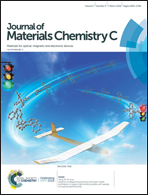An arylphosphine oxide and phosphonate combination as a solution processable electron injection layer for power-efficient PLEDs†
Abstract
A solution-processable all organic mixed SPPO13:TPPO electron injection layer (EIL) has been reported. This mixed EIL can inherit both the perfect electron transporting properties of SPPO13 from arylphosphine oxide and the good electron injection properties of TPPO from phosphonate, making it suitable for working at a very thick film thickness of about 50 nm. Moreover, the introduction of TPPO with a superior film-forming ability to SPPO13 endows the mixture with an improved film morphology to favor electron injection from the cathode to the EIL. As a result of the high solubility of the two materials in alcohols, fully solution-processed multi-layer PLEDs could be fabricated through orthogonal solvent processing. The blue, green, red and white-emitting PLEDs show high power efficiencies of about 5.3, 17.6, 3.4 and 9.0 lm W−1, respectively. This result clearly indicates that the combination of arylphosphine oxide and phosphonate creates a promising solution-processable EIL that can be used for power-efficient PLEDs.



 Please wait while we load your content...
Please wait while we load your content...